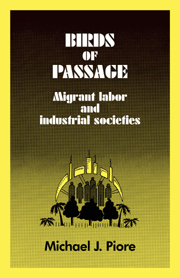Book contents
- Frontmatter
- Contents
- Preface
- 1 Introduction
- 2 The jobs
- 3 The migrants
- 4 Particular characteristics of the migrant labor market
- 5 The impact of migration on the place of origin
- 6 The historical evolution of long-distance migration in the United States
- 7 The dilemmas of current U.S. immigration policy
- Notes
- Bibliography
- Index
7 - The dilemmas of current U.S. immigration policy
Published online by Cambridge University Press: 28 October 2009
- Frontmatter
- Contents
- Preface
- 1 Introduction
- 2 The jobs
- 3 The migrants
- 4 Particular characteristics of the migrant labor market
- 5 The impact of migration on the place of origin
- 6 The historical evolution of long-distance migration in the United States
- 7 The dilemmas of current U.S. immigration policy
- Notes
- Bibliography
- Index
Summary
The United States is not a closed economy. The country admits four hundred thousand permanent immigrants annually. But the immigration system has not been designed to meet the nation's manpower needs. The bulk of permanent immigrants are ostensibly coming for personal reasons, for example, to join family already here; many are not members of the labor force. The legal system operates to exclude a vast number of people who want to come to the United States to work and whom the economy is able to absorb. A large proportion of these excluded people enter and work, despite the law. Estimates of the number of these undocumented workers here at any one time imply that they are from four and a half to three times the resident alien population. The highest estimates would make them more than 10 percent of the labor force. The presence of these people has become the central dilemma of U.S. immigration policy.
The goals of immigration policy
Understood in conventional terms, the dilemma is apparently insoluble and has a virtually unique capacity to divide people who on other issues are united by their concern for underprivileged and disadvantaged groups. It appears that one must choose between the migrants, who are seeking entry in order to escape the poverty of their own country, and native workers, who, however well off in comparison to the migrants with whom they must compete in the lower reaches of the labor market, feel themselves to be a disadvantaged and underprivileged class.
- Type
- Chapter
- Information
- Birds of PassageMigrant Labor and Industrial Societies, pp. 167 - 192Publisher: Cambridge University PressPrint publication year: 1979



